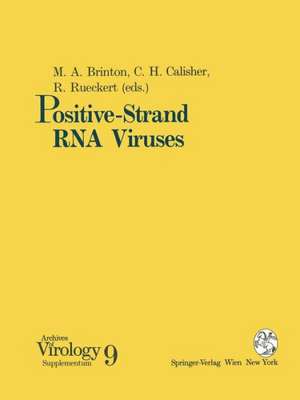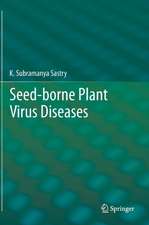Positive-Strand RNA Viruses: Archives of Virology. Supplementa, cartea 9
Editat de Margo A. Brinton, Charles H. Calisher, Roland Rueckerten Limba Engleză Paperback – 16 mar 1994
Din seria Archives of Virology. Supplementa
-
 Preț: 404.29 lei
Preț: 404.29 lei -
 Preț: 428.56 lei
Preț: 428.56 lei -
 Preț: 391.40 lei
Preț: 391.40 lei - 5%
 Preț: 381.54 lei
Preț: 381.54 lei - 5%
 Preț: 1102.31 lei
Preț: 1102.31 lei - 5%
 Preț: 1313.93 lei
Preț: 1313.93 lei - 18%
 Preț: 961.55 lei
Preț: 961.55 lei - 24%
 Preț: 820.00 lei
Preț: 820.00 lei -
 Preț: 393.52 lei
Preț: 393.52 lei - 5%
 Preț: 1014.10 lei
Preț: 1014.10 lei - 15%
 Preț: 600.26 lei
Preț: 600.26 lei - 18%
 Preț: 1234.94 lei
Preț: 1234.94 lei -
 Preț: 397.76 lei
Preț: 397.76 lei - 5%
 Preț: 384.80 lei
Preț: 384.80 lei -
 Preț: 414.30 lei
Preț: 414.30 lei -
 Preț: 399.29 lei
Preț: 399.29 lei -
 Preț: 401.24 lei
Preț: 401.24 lei -
 Preț: 401.03 lei
Preț: 401.03 lei
Preț: 424.33 lei
Nou
Puncte Express: 636
Preț estimativ în valută:
81.19€ • 84.77$ • 67.20£
81.19€ • 84.77$ • 67.20£
Carte tipărită la comandă
Livrare economică 04-18 aprilie
Preluare comenzi: 021 569.72.76
Specificații
ISBN-13: 9783211825228
ISBN-10: 3211825223
Pagini: 572
Ilustrații: X, 558 p. 183 illus.
Dimensiuni: 210 x 279 x 30 mm
Greutate: 1.27 kg
Ediția:Softcover reprint of the original 1st ed. 1994
Editura: SPRINGER VIENNA
Colecția Springer
Seria Archives of Virology. Supplementa
Locul publicării:Vienna, Austria
ISBN-10: 3211825223
Pagini: 572
Ilustrații: X, 558 p. 183 illus.
Dimensiuni: 210 x 279 x 30 mm
Greutate: 1.27 kg
Ediția:Softcover reprint of the original 1st ed. 1994
Editura: SPRINGER VIENNA
Colecția Springer
Seria Archives of Virology. Supplementa
Locul publicării:Vienna, Austria
Public țintă
ResearchCuprins
Keynote address.- The importance of antigenic variation in vaccine design.- Strategies for control of virus diseases.- The genetic and functional basis of HIV-1 resistance to nonnucleoside reverse transcriptase inhibitors.- Structure-based design of symmetric inhibitors of HIV-1 protease.- Age-dependent susceptibility to fatal encephalitis: alphavirus infection of neurons.- Principles and background for the construction of transgenic plants displaying multiple virus resistance.- The structure of an immunodominant loop on foot and mouth disease virus, serotype O1, determined under reducing conditions.- Immunopathologic mechanisms of dengue hemorrhagic fever and dengue shock syndrome.- Molecular aspects of pathogenesis and virulence.- Cardioviral poly(C) tracts and viral pathogenesis.- Transgenic mice and the pathogenesis of poliomyelitis.- Adaptation of positive-strand RNA viruses to plants.- A molecular genetic approach to the study of Venezuelan equine encephalitis virus pathogenesis.- Use of drug-resistance mutants to identify functional regions in picornavirus capsid proteins.- Flock house virus: a simple model for studying persistent infection in cultured Drosophila cells.- Genome replication and transcription.- Protein-protein interactions and glycerophospholipids in bromovirus and nodavirus RNA replication.- Characteristics of the poliovirus replication complex.- Secretory pathway function, but not cytoskeletal integrity, is required in poliovirus infection.- Role of sub-genomic minus-strand RNA in Coronavirus replication.- Common replication strategies emerging from the study of diverse groups of positive-strand RNA viruses.- Preferential replication of defective turnip yellow mosaic virus RNAs that express the 150-kDa protein in cis.- In vivo transfection by hepatitis A virus synthetic RNA.- RNA recombination.- Recombination between Sindbis virus RNAs.- Homologous RNA recombination allows efficient introduction of site-specific mutations into the genome of Coronavirus MHV-A59 via synthetic co-replicating RNAs.- Targeting of the site of nonhomologous genetic recombination in brome mosaic virus.- Natural recombination in bovine viral diarrhea viruses.- Sequences at the ends of RNA-2 of 16, a recombinant tobravirus.- RNA-protein interactions and host-virus interactions.- Identification and characterization of host factor interactions with cis-acting elements of rubella virus RNA.- Interaction of cellular proteins with the poliovirus 5? noncoding region.- IRES-controlled protein synthesis and genome replication of poliovirus.- Analysis of hepatitis A virus translation in a T7 polymerase-expressing cell line.- Purification and characterization of the U-particle, a cellular constituent whose synthesis is stimulated by mengovirus infection.- B-lymphocytes are predominantly involved in viral propagation of hepatitis C virus (HCV).- Protein expression and virion maturation.- Folding of the mouse hepatitis virus spike protein and its association with the membrane protein.- Assembly and entry mechanisms of Semliki Forest virus.- The interactions of the flavivirus envelope proteins: implications for virus entry and release.- Coronavirus polyprotein processing.- Processing of dengue type 4 and other flavivirus nonstructural proteins.- Nuclear targeting of Semliki Forest virus nsP2.- RNA replication.- Replication and translation of cowpea mosaic virus RNAs are tightly linked.- Alphavirus positive and negative strand RNA synthesis and the role of polyproteins in formation of viral replication complexes.- Nodavirus RNA replication:mechanism and harnessing to vaccinia virus recombinants.- Molecular characterization of Borna virus RNAs.- Genomic organization and expression of astroviruses and calciviruses.- Lelystad virus belongs to a new virus family, comprising lactate dehydrogenase- elevating virus, equine arteritis virus, and simian hemorrhagic fever virus.- Virus receptors.- Recognition of cellular receptors by bovine corona-virus.- Mouse hepatitis virus receptors: more than a single carcinoembryonic antigen.- Host-cell receptors for Sindbis virus.- Cell surface receptor for ecotropic host-range mouse retroviruses: a cationic amino acid transporter.- Virus structure and assembly.- Comparative studies of T = 3 and T = 4 icosahedral RNA insect viruses.- Retroviral RNA packaging: a review.- Structural studies of viruses by electron cryomicroscopy.- Crystallographic and cryo EM analysis of virion-receptor interactions.- Assembly of tobacco mosaic virus and TMV-like pseudovirus particles in Escherichia coli.




